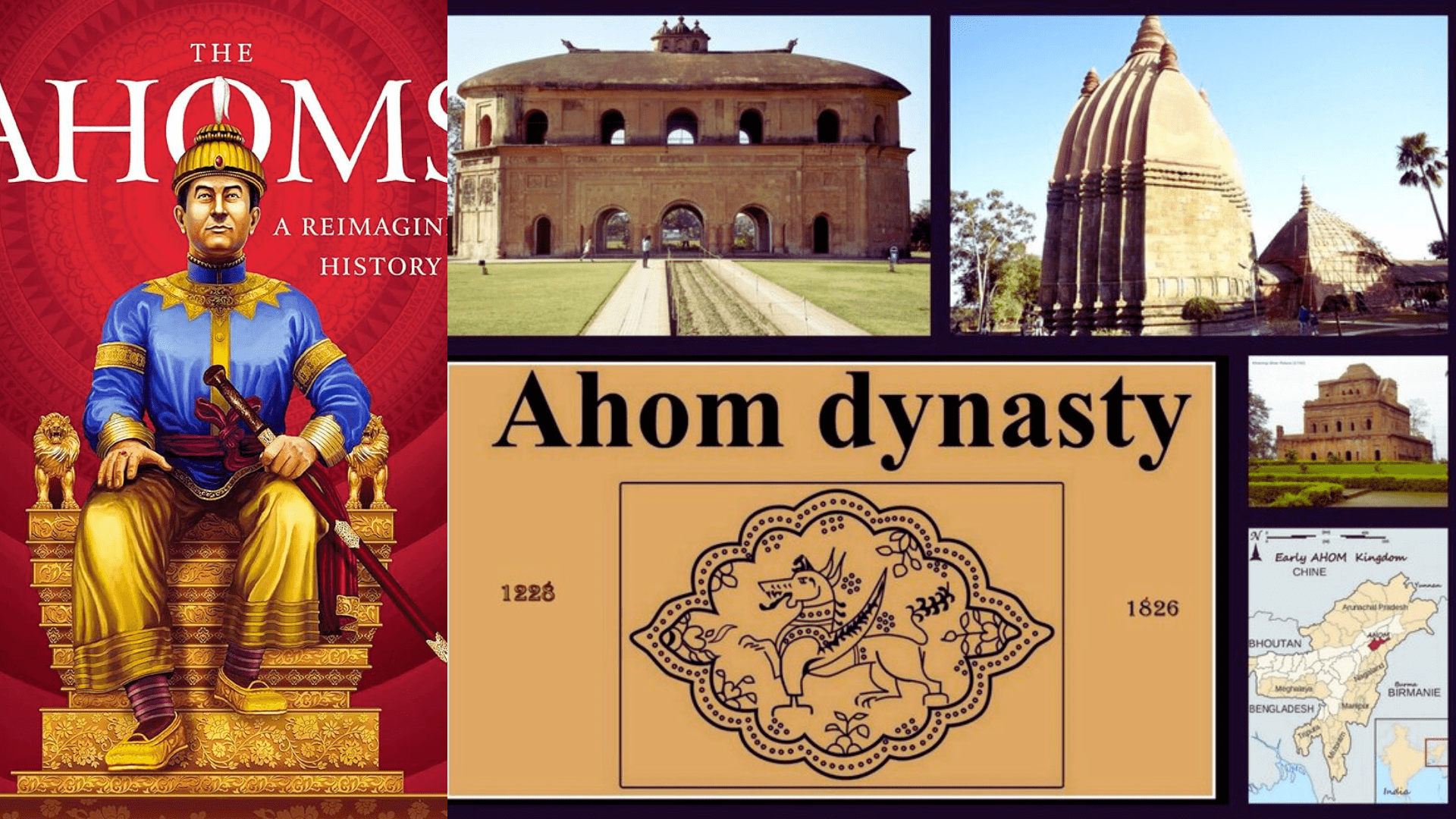The founder of the Ahom Dynasty is Chaolung Sukaphaa. He was a Shan prince from Mong Mao, present-day Yunnan, China. Sukaphaa established the Ahom dynasty in 1228 after crossing the Patkai mountains and entering Assam, where he founded the Kingdom of Ahom. This kingdom went on to rule Assam for six centuries, significantly shaping the region’s history and culture.
The Legendary Founder: Sukaphaa
The Early Life of Sukaphaa
Sukaphaa, the illustrious founder of the Ahom Kingdom in 1228, stands as a monumental figure in the history of Assam. Known by titles such as Chaolung Sukaphaa, where “Chao” signifies “Lord” and “Lung” denotes “Great”, he was the inaugural Ahom king, setting the cornerstone for a dynasty that would rule Assam for approximately six centuries. Originating from a lineage that intertwined with the divine, Sukaphaa’s birth is enveloped in a narrative that highlights his destined greatness and the profound impact he was to have on the lands that lay beyond the Patkai mountains.
Before his epochal journey to Assam, Sukaphaa hailed from the region known today as Yunnan in China, signifying his roots in the Tai Ahom community. His venture into Assam wasn’t merely a quest for new territories but a mission imbued with the vision of creating a socio-political entity that would thrive through the ethos of unity, cultural assimilation, and administrative acumen. His reign, commencing in 1228 and concluding in 1268, was marked by significant expansions, strategic governance, and the laying down of a sociopolitical foundation that would influence the region’s ethos profoundly.
The early life of Sukaphaa, therefore, isn’t just a tale of royal lineage and adventurous expedition but a narrative that underscores the qualities of leadership, vision, and determination. His legacy, enduring through centuries, continues to be celebrated in Assam, encapsulating the spirit of diversity, resilience, and unity.
Sukaphaa’s Journey to Assam
Sukaphaa’s journey to Assam marked the beginning of a significant era in the region’s history. A Shan prince hailing from Mong Mao (present-day Yunnan, China), Sukaphaa embarked on a visionary quest, crossing the formidable Patkai mountains to reach Assam in 1228. His arrival in Namrup, Assam, on 2nd December 1228, is a date celebrated as the moment that laid the foundations of the Ahom Empire, which would govern the region for six centuries.
Sukaphaa’s initial expedition was not just a mere migration but a strategic move towards establishing a new kingdom that would encompass the entirety of upper Assam, stretching from the southwest of the Chutias to the east of the Kacharis. His leadership and diplomatic skills enabled him to unify various tribal communities under his rule, laying the groundwork for a diverse and cohesive society. Through his policy of amity and unity, Sukaphaa became the architect of greater Assam, fostering a vibrant cultural and political landscape that endures in the collective memory of the Assamese people.
The Expansion and Administration
Territorial Expansions
The Ahom Kingdom’s territorial expansions were marked by significant achievements and administrative adaptations. This process, especially notable until the 16th century under Suhungmung’s reign, led to large territorial gains at the cost of neighboring entities. These expansions brought about profound changes within the kingdom, such as the Assamese-speaking Hinduized subjects outnumbering the Ahoms themselves, and the absorption of diverse cultures and peoples into the Ahom fold.
Moreover, the Ahom Kingdom’s encounters with the Mughal Empire’s revenue systems during its expansions into Mughal territories facilitated the integration of these systems into the Ahom administrative framework. This adaptation contributed significantly to the kingdom’s administrative efficiency.
The Ahom rulers, of Tai-Ahom ethnic origin, were recognized for creating a potent kingdom renowned for its military prowess and administrative acumen, effectively managing the expanded territories. Following the Mughals’ final expulsion from Lower Assam by 1681, the Ahom state experienced further territorial consolidation and increased Hinduisation, shaping its socio-political fabric.
Governance and Military Strategies
The Ahom dynasty, ruling for over 600 years, implemented formidable military strategies and governance systems to sustain their empire. Their military administration was notable for its effective defense strategies against external invasions, including the Mughal Empire. The Ahom kingdom, utilizing guerrilla warfare tactics, showcased the expertise of Ahom soldiers in non-traditional combat methods. This approach was particularly evident in significant conflicts like the Battle of Saraighat, where military strategy and diplomatic intricacies played a crucial role in their victory.
Governance under the Ahoms was inclusive, with the king at its helm, possibly involving the populace in war strategies before leading an expedition. The Ahom dynasty’s Swargadeos (kings) also implemented effective defensive measures to protect the kingdom, suggesting a blend of military might and strategic governance that contributed to the long-term sustainability of their rule.
Cultural Contributions and Legacy
Architectural Marvels
The Ahom Dynasty, ruling for nearly 600 years, left an indelible mark on Assam’s cultural and architectural landscape. Their contributions include majestic temples, palaces, and monuments that underscore the dynasty’s architectural brilliance and cultural depth. Notably, the Ahom kings introduced innovative construction techniques, utilizing materials like fish, duck eggs, and sticky rice, which contributed to the durability and uniqueness of their architectural works. Their reign was marked by prosperity and the flourishing of arts, literature, and engineering, enriching the region’s architectural and cultural heritage significantly. The legacy of the Ahom Dynasty, with its distinctive architectural style, continues to be a significant aspect of Assamese identity and heritage.
The Ahom Festivals and Rituals
The Ahom community, integral to Assam’s cultural fabric, celebrates various festivals and rituals, deeply rooted in their history and beliefs. Among these, two standout celebrations are Me-Dam-Me-Phi and Bihu, each holding unique significance and practices:
- Me-Dam-Me-Phi: This is a significant Ahom festival, celebrated to honor the ancestors. It is a day of remembrance and paying respects to the deceased, reflecting the community’s deep-rooted ancestral veneration.
- Bihu: While not exclusive to the Ahoms, Bihu is a prominent festival in Assam celebrated by all, including the Ahoms. It consists of three major types: Rongali, Magh, and Bhogali Bihu, each marking different seasonal cycles and agricultural milestones. It encapsulates the vibrancy of Assam’s culture and is celebrated with much fervor across communities.
These festivals reflect the Ahoms’ rich cultural traditions and their influence on the broader socio-cultural practices in Assam, showcasing a blend of ancestral worship and agricultural rites.
The Decline of the Ahom Dynasty
Internal Conflicts and External Threats
The decline of the Ahom Dynasty, a significant power in Northeast India for almost 600 years, can be attributed to a combination of internal conflicts and external threats. Key factors include:
- Moamoria Rebellion: A major internal uprising that weakened the kingdom significantly, disrupting the social and administrative fabric of the Ahom state.
- Weak Successors and Economic Downfall: Following the reign of strong leaders, the emergence of weaker successors contributed to the kingdom’s decline, compounded by economic difficulties due to prolonged conflicts and mismanagement.
- Conflicts Over Internal Issues: Disputes within the kingdom, such as those between the Ahom rulers and the Sattaras (Vaishnavite monasteries), further destabilized the region.
- Continuous External Threats: The kingdom faced several external invasions and conflicts, including repeated attacks by the Mughals and the Burmese, which strained its resources and military.
- Burmese Invasions and the Treaty of Yandabo: The repeated Burmese invasions in the early 19th century and the subsequent Treaty of Yandabo in 1826, which placed the kingdom under British control, marked the final downfall of the Ahom dynasty.
The Last Days of Ahom Rule
The final years of the Ahom rule were marked by a series of internal and external challenges that eventually led to its decline. Established in 1228 by Sukaphaa, a Shan prince, the Ahom dynasty ruled for nearly 598 years in present-day Assam, India. Despite its resilience against numerous invasions and maintaining independence for nearly 600 years, the dynasty faced critical challenges towards its end:
- Moamoria Rebellion (1769-1805): This internal rebellion significantly weakened the Ahom rule, causing political instability and internal conflict.
- First Anglo-Burmese War: The British annexation of territory following this war sparked the Ahom revolts in Assam as a reaction to British imperialism, signaling the beginning of the end of Ahom sovereignty.
- Treaty of Yandabo (1826): The Ahom kingdom’s fate was sealed when it was ceded to the British Empire after the First Anglo-Burmese War, ending nearly six centuries of Ahom rule.
Despite their fall, the Ahom dynasty left a lasting impact on the socio-cultural landscape of Assam, evident in the region’s rich heritage and traditions.
Conclusion
The story of Sukaphaa and the Ahom Dynasty is not just a historical account; it’s a narrative of resilience, innovation, and unity. As we explore the rich tapestry of India’s past, the tale of Sukaphaa serves as a reminder of the enduring power of vision and leadership.
Read also: Who is Kavya Maran?




